Think back to your school days … rows of desks … the teacher up front … the sitting, sitting, sitting all day while you absorbed facts and more facts. That was schooling based on an early 20th century industrial model. It doesn’t work anymore.
Tomorrow’s challenges require that students develop leadership skills and personal value sets that cannot be acquired from passively learning the “three Rs.” Students best learn these skills through hands-on connections to problem-solving within the world around them.
Yet, the average American child spends just four to seven minutes in unstructured outdoor play each day and more than seven hours in front of an electronic screen, according to the National Wildlife Federation. This shift to indoor living is creating kids who are tuned out and stressed out, and they are missing something essential to their physical and emotional development: connection to the natural world.
Experts have concluded that students active in outdoor education programs often sharpen critical thinking skills, learn to work with partners or in teams, and formulate strategies that can be applied in the real world. The North American Association for Environmental Education has found that outdoor education helps children learn to problem-solve, take the long-term view and gain a sense of making a difference in the world.
Many children, especially those from low-income families, might not have access to programs that offer these types of skill-building. But Keep Austin Beautiful and Explore Austin are intervening. Both groups use the great outdoors to teach skills that children might not learn in the typical classroom.
At Keep Austin Beautiful, nature is a place to apply learning
Keep Austin Beautiful (KAB) has evolved from an organization focused primarily on fostering environmental stewardship through litter clean-up and beautification projects to one that infuses education and leadership in students and adults alike. In fact KAB believes in a ‘knowledge is power’ model in which having the background coupled with the skills will create lifelong environmental stewards.
When founded in 1985, KAB aimed for a litter-free Austin, says Monica Lopez Magee, KAB Development & Communications Director. But in 2004, the KAB board expand into environmental education — a move that “stemmed from community need and filled a gap” in KAB’s efforts to promote stewardship of neighborhoods and natural resources.
“The window to be outdoors today is small for kids of all income levels,” Lopez says. “They’re used to a more enclosed and ordered environment. At first, many are nervous about encountering insects or critters, for example, or even about the expansiveness of outdoors.” This is where older students can mentor younger ones who are looking for role models, she says.
What started simply — integrating education components into clean-ups — has grown into school-based programs that involve more than 8,500 kids annually.
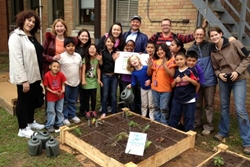 The school-wide Clean Creek Campus program helps organize service-learning projects such as restoring parks and building vegetable gardens. Additionally, KAB is administering the City’s new Generation Zero program which engages students in lessons about recycling, composting and conservation while providing simple solutions for reducing waste Green Teens, an after-school program at five campuses in East and South Austin, enables youth to develop environmental resourcefulness and to grow as leaders — and its classroom is the outdoors.
The school-wide Clean Creek Campus program helps organize service-learning projects such as restoring parks and building vegetable gardens. Additionally, KAB is administering the City’s new Generation Zero program which engages students in lessons about recycling, composting and conservation while providing simple solutions for reducing waste Green Teens, an after-school program at five campuses in East and South Austin, enables youth to develop environmental resourcefulness and to grow as leaders — and its classroom is the outdoors.
“Green Teens is an in-depth approach to learning stewardship, and it also encourages working together, communicating and helping each other,” Lopez says.
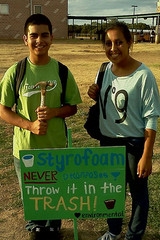 Kids get involved in projects such as native gardening, exploring our local environment, campus or neighborhood beautification, and even experiencing their first camping trip. They explore nearby creeks to learn about water quality and aquatic life. They learn principles of water conservation by studying native plants, and they see the value of recycling after visiting a landfill.
Kids get involved in projects such as native gardening, exploring our local environment, campus or neighborhood beautification, and even experiencing their first camping trip. They explore nearby creeks to learn about water quality and aquatic life. They learn principles of water conservation by studying native plants, and they see the value of recycling after visiting a landfill.
To promote enthusiasm and involvement, the group lets students select projects.
“Our job is to feed kids’ interests in environmentalism, to capitalize on what they already care about and to help them become self-regulating and self-accountable along the way,” Lopez says.
Initially, the students are often focused on needs in their own neighborhoods, she said, such as at LBJ High School where the students cleaned up a nearby illegal dump site.
Though Green Teens’ projects are environmentally-focused, they also encompass a variety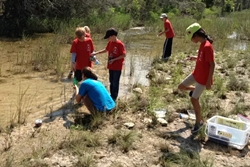 of academic disciplines. Garden design, for example, uses math and engineering skills; growing vegetables is a science lesson; recycling projects teach economics and communications; technology skills are honed as students track data, use Skype with peers from other schools, and report results in computer presentations and blogs. In the case of the illegal dump site near LBJ High School, students researched civic ordinances about illegal dumping.
of academic disciplines. Garden design, for example, uses math and engineering skills; growing vegetables is a science lesson; recycling projects teach economics and communications; technology skills are honed as students track data, use Skype with peers from other schools, and report results in computer presentations and blogs. In the case of the illegal dump site near LBJ High School, students researched civic ordinances about illegal dumping.
“They discover real-life applications to what they’re learning in the classroom,” Lopez says. “They see there’s practicality in what their teachers are presenting to them.
“In the decades ahead, environmental stewardship will require us to be well-rounded academically. Isn’t that the goal of education?”
As Green Teens students graduate, some go on to higher education and some go straight to work. Lopez has goals for each of them.
“I want the environment to be a factor in their daily choices, that they teach their own children to be good stewards, and that being in the outdoors is a way of life for them,” she says.
Get Involved with Keep Austin Beautiful
Explore Austin carves out a path to leadership
Jen Ohlson calls it the “awe factor,” and it’s a key component in the success of Explore Austin, a nonprofit that uses the outdoors to develop leadership skills in underserved teens.
“Outdoor experiences teach that life is bigger than you,” Ohlson, an Explore Austin board member, says. “To master an outdoor skill gives a sense of achievement and builds confidence.”
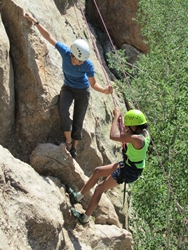 Explore Austin, founded in 2006, offers outdoor adventure in a six-year program for sixth- through 12th-grade students. In seven Saturday events during the school year and a week-long summer wilderness trip to Colorado, the youths, called “explorers,” challenge themselves in activities that city kids rarely experience — hiking, mountain biking, orienteering, backpacking, rock climbing, kayaking, raft building, fly fishing, and a guided ropes course.
Explore Austin, founded in 2006, offers outdoor adventure in a six-year program for sixth- through 12th-grade students. In seven Saturday events during the school year and a week-long summer wilderness trip to Colorado, the youths, called “explorers,” challenge themselves in activities that city kids rarely experience — hiking, mountain biking, orienteering, backpacking, rock climbing, kayaking, raft building, fly fishing, and a guided ropes course.
The goal is to experience adventure, and more importantly, to help explorers develop leadership and mentoring abilities.
“Nothing can accelerate that faster than being in nature,” Ohlson says.
“Nature provides that balance in life that we all need,” she says. “There is both solitude and challenge. We are both participator and creator. Kids respond to that. They sense it and feel empowered. They change from the experience.”
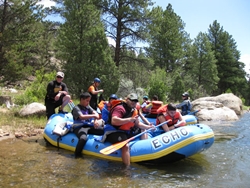 Explore Austin works exclusively with kids who attend KIPP Austin Public Schools, a network of nine charter schools serving more than 2,000 students in East Austin. For its first five years, the program served only boys because so many boys lack adult male role models, Ohlson says. Three years ago, girls joined the program.
Explore Austin works exclusively with kids who attend KIPP Austin Public Schools, a network of nine charter schools serving more than 2,000 students in East Austin. For its first five years, the program served only boys because so many boys lack adult male role models, Ohlson says. Three years ago, girls joined the program.
Explore Austin began with 16 kids. This year, 150 are in the program. All are mentored by adult volunteers who want to “share their passion for the outdoors,” Ohlson says. Explorers participate for free, and all money is raised locally.
Underserved youths need the kind of experiences that Explore Austin offers because they lack opportunities to be outside, Ohlson says.
“They often have parents who are working more than one job and don’t have time, for instance, to take them for an outing on the hike and bike trail. And financial issues also create barriers to outdoor adventure,” Ohlson says.
Explore Austin activities focus on developing physical skills, but character development is just as important.
“We’ve seen that when kids discover purpose and develop personal accountability, things come into alignment for them,” Ohlson says. Older, experienced explorers mentor the younger ones, offering advice and support in physical challenges.
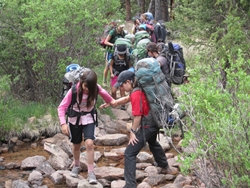 “Kids learn to be responsible for themselves, but also for each other. The student mentors can say, ‘I didn’t know how to ride a bike either when I was your age. You can do it. I’ll help you.’ That message coming from them is powerful,” Ohlson says.
“Kids learn to be responsible for themselves, but also for each other. The student mentors can say, ‘I didn’t know how to ride a bike either when I was your age. You can do it. I’ll help you.’ That message coming from them is powerful,” Ohlson says.
The kids benefit academically, she says, as they develop insight into their strengths and interests and learn to set and work toward goals. Of the 15 boys who graduated from KIPP and Explore Austin in 2012, all are now enrolled in college, the first members of their families to do so.








